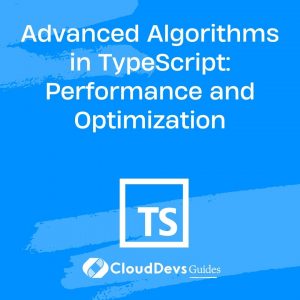Advanced algorithms in TypeScript
In the realm of computer science, algorithms are the backbone of problem-solving. As developers, we often encounter situations where we need to tackle complex problems efficiently. This is where advanced algorithms come into play. In this blog post, we will delve into the world of advanced algorithms using TypeScript and explore techniques for optimizing their performance.
Table of Contents
1. Understanding Advanced Algorithms
Advanced algorithms are sophisticated techniques that offer efficient solutions to complex computational problems. They often involve intricate data structures and clever strategies to tackle problems that cannot be easily solved using traditional methods. These algorithms find applications in a wide range of domains, including machine learning, cryptography, network analysis, and more.
2. The Need for Optimization
While advanced algorithms provide powerful solutions, they can also be computationally expensive. As the complexity of the problem increases, the execution time and resource consumption of these algorithms can become significant. This is where optimization becomes crucial. Optimization involves enhancing the algorithm’s efficiency without compromising its correctness.
3. Common Optimization Techniques
Let’s explore some common optimization techniques that can be applied to advanced algorithms to improve their performance.
3.1. Memoization
Memoization is a technique used to store the results of expensive function calls and return the cached result when the same inputs occur again. This technique is particularly useful for algorithms with overlapping subproblems, such as dynamic programming algorithms.
typescript
const memo: Map<number, number> = new Map();
function fibonacci(n: number): number {
if (memo.has(n)) {
return memo.get(n)!;
}
if (n <= 1) {
return n;
}
const result = fibonacci(n - 1) + fibonacci(n - 2);
memo.set(n, result);
return result;
}
3.2. Divide and Conquer
Divide and Conquer is a technique that involves breaking down a problem into smaller subproblems, solving them independently, and then combining their solutions to obtain the final result. This technique is widely used in algorithms like merge sort and binary search.
typescript
function mergeSort(arr: number[]): number[] {
if (arr.length <= 1) {
return arr;
}
const middle = Math.floor(arr.length / 2);
const left = arr.slice(0, middle);
const right = arr.slice(middle);
return merge(mergeSort(left), mergeSort(right));
}
function merge(left: number[], right: number[]): number[] {
// Merge the sorted left and right arrays
// ...
}
3.3. Dynamic Programming
Dynamic programming is a technique used to solve problems by breaking them down into smaller overlapping subproblems. The solutions to these subproblems are stored in a table to avoid redundant calculations. This technique is applied in algorithms like the Knapsack problem and shortest path algorithms.
typescript
function knapsack(values: number[], weights: number[], capacity: number): number {
const dp: number[][] = Array.from({ length: values.length + 1 }, () =>
Array(capacity + 1).fill(0)
);
for (let i = 1; i <= values.length; i++) {
for (let w = 1; w <= capacity; w++) {
if (weights[i - 1] <= w) {
dp[i][w] = Math.max(
values[i - 1] + dp[i - 1][w - weights[i - 1]],
dp[i - 1][w]
);
} else {
dp[i][w] = dp[i - 1][w];
}
}
}
return dp[values.length][capacity];
}
4. Performance Tuning
In addition to these optimization techniques, there are general practices you can follow to further enhance the performance of your advanced algorithms.
4.1. Use Efficient Data Structures
Choose the appropriate data structures for your algorithm. For example, when dealing with frequent insertions and deletions, consider using data structures like hash maps or balanced binary search trees.
4.2. Profile and Benchmark
Profile your code to identify bottlenecks and areas for improvement. Use tools to measure the execution time of different parts of your algorithm. Benchmarking helps you make informed decisions about which optimizations to apply.
4.3. Parallelism and Concurrency
For algorithms that can be parallelized, consider utilizing multi-threading or asynchronous programming to take advantage of modern hardware capabilities.
4.4. Optimize Memory Usage
Reduce memory usage by minimizing unnecessary data storage, using memory-efficient data structures, and avoiding memory leaks.
5. Putting It All Together
Let’s see how we can apply these optimization techniques to a real-world problem: finding the shortest path in a graph using Dijkstra’s algorithm.
typescript
class PriorityQueue<T> {
// Priority queue implementation
// ...
}
function dijkstra(graph: Map<string, Map<string, number>>, start: string, end: string): number {
const distances: Map<string, number> = new Map();
const queue = new PriorityQueue<string>();
for (const vertex of graph.keys()) {
distances.set(vertex, Infinity);
}
distances.set(start, 0);
queue.enqueue(start, 0);
while (!queue.isEmpty()) {
const [current, distance] = queue.dequeue()!;
if (current === end) {
return distance;
}
if (distance > distances.get(current)!) {
continue;
}
for (const [neighbor, weight] of graph.get(current)!.entries()) {
const newDistance = distance + weight;
if (newDistance < distances.get(neighbor)!) {
distances.set(neighbor, newDistance);
queue.enqueue(neighbor, newDistance);
}
}
}
return -1; // No path found
}
In this example, we’ve used a priority queue to optimize the selection of the next vertex with the shortest distance. We’ve also applied memoization to avoid recalculating distances and used efficient data structures for storing distances and the graph.
Conclusion
Advanced algorithms provide powerful solutions to complex problems, but their performance can be a concern. By applying optimization techniques such as memoization, divide and conquer, and dynamic programming, and by following best practices like profiling and using efficient data structures, we can significantly enhance the performance of these algorithms.
As developers, understanding when and how to optimize algorithms is crucial for creating efficient and responsive applications. By exploring the world of advanced algorithms and mastering optimization techniques, you’ll be better equipped to tackle challenging computational problems in your projects. So, dive into the fascinating realm of advanced algorithms, optimize them for peak performance, and unleash the true potential of your applications. Happy coding!
Table of Contents









